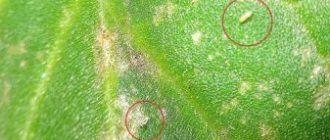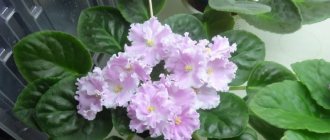Breeders and flower growers fell in love with the African violet so much that in less than 130 years since its discovery, thousands of its varieties have been bred. The plant has changed both the modest blue-violet color of its flowers, as well as their shape and size. The leaves have also changed.
Saintpaulias have become so popular that they are grown in almost every home. There are individual lovers of this flower, whose collections approach a thousand copies. Exhibitions of violets are held regularly, where new varieties are presented. It is simply impossible to talk about everyone at once. Let's get acquainted with individual creations of Russian and foreign selection.
Botanical description of the plant
Ballerina forms a dense rosette of elastic leaves from 20 cm to 40 cm in height. The leaf blade is dark green, oval in shape, with a wavy edge. The young plant blooms about a year after planting. In spring, long flower stalks with numerous buds appear.
Did you know? Violets were the favorite flowers of Josephine Beauharnais, the French empress; she pinned a bouquet of flowers to her dress and decorated her rooms with them.
This variety has virtually no breaks in flowering: as soon as one peduncle fades, the next one appears in new leaves. In this case, the flowers last for about 2 months. The exception is winter, a relative period of rest. Large terry baskets up to 7 cm in diameter are painted white. The petals are arranged in several rows, the middle of the flower is yellow.
Features of flowering, growth and reproduction
It grows quickly, but until it develops a rosette, it will not produce full flowering. It can bloom at the starter age, but most often it is several flower stalks with sparse buds. It will take about a year to grow a full-fledged rosette.
Varietal characteristics are conveyed well ; specimens with a complete absence of fantasy inclusions appear very rarely. The easiest way to grow a new plant is from a leaf.
Prefers cooler conditions . Prefers temperatures ranging from +18 to +22 C0.
Peduncles are tall and thin. They are not able to hold the buds suspended, and the flowers are scattered across the surface of the rosette.
Important! In order for the rosette to produce a full head of flowers, cool conditions should be provided, as well as lighting for at least 14 hours.
The buds bloom for a long time, but a few weeks after flowering they begin to lighten. To ensure that the socket retains its attractive appearance, they are cut off.
Conditions for successful growing at home
Violets are, in principle, unpretentious plants; creating the necessary temperature and humidity conditions is not difficult for them.
Placement and lighting
Saintpaulia (the second name for indoor violet) RS-Ballerina - the owner of dark leaves. Such varieties are placed on window sills closer to the glass, on racks - in the first row from the lamp. If the window sills are south, it is advisable to shade them from direct rays of the sun, for example, with white thick paper. In winter, flowers will need to extend daylight hours; the best lighting option would be a fluorescent lamp. Daylight hours should last at least 10 hours.
Did you know? According to Christian myths, violets grew from the tears of Adam, to whom the Archangel Gabriel brought news of the forgiveness of sins.
Temperature and humidity
The most comfortable temperature is +20...+22°C, night temperatures can drop to +19°C. Sudden changes and drafts can lead to disease and death of the flowerpot. The optimal air humidity is 50–60%. In winter, when heating appliances are operating, the air in apartments and houses is dry. To prevent the violet from suffering from this, place a tray with damp expanded clay or moss near the pot. The microclimate around the plant will be what it needs.
Reviews about violet
Marina, Odessa: “The variety loves frequent transplants and responds well to fertilization. But the peduncles are really thin, long and weak. I only keep it for the beautiful shade, which is very rare.”
Zoya, Voronezh: “I often have a desire to get rid of this variety. Peduncles are like strings, always lying on the rosette. The only thing that saves is frequent and abundant flowering.”
How to care at home
Its development and the duration of flowering of the bush depend on the quality care of Saintpaulia.
Important! Spraying the bush is not recommended: the pubescent leaves trap water droplets, increasing the risk of fungal diseases.
Watering
To water the flower, use water that has been standing for at least a day at a temperature of +20°C. Since the bush forms a dense rosette, overhead watering will be inconvenient. In this case, it is better to use watering through a tray. Water is poured in small portions, then left for 10–15 minutes, the remaining water is drained. The frequency of watering will depend on the degree of drying of the top layer of soil 1.5 cm.
Fertilizer application
Long-blooming violets need to constantly replenish their supply of nutrients, so the plants are fed 2 times a month. Balanced mineral complexes are used, for example “Bona Forte for violets and begonias”. According to the instructions, for root feeding you need to dilute 10 ml/1.5 l of water. Experienced flower growers recommend halving the dosage from the manufacturer.
Important! You cannot fertilize a sick plant unless the disease is caused by a lack of nutrition.
Transfer
Every spring, the bush requires soil renewal. The plant is removed from the old container by tapping the edges. Gently shake off the adhering soil; if there are traces of oxidation, it is better to rinse the roots with water and dry them before replanting. Roots that are too long or diseased, damaged roots are trimmed, and the sections are sprinkled with crushed activated carbon.
The surface root system of the plant does not tend to grow much in volume or depth: as the bush grows, old roots die off, and new ones form above the soil surface under the lower leaves, so a new pot is needed no more than 10 cm in volume and the same in height.
To prepare the soil mixture you will need the following components:
- garden soil - 2 parts;
- perlite - 2 parts;
- river sand - 1 part;
- peat - 1 part.
Transplant technology:
- 2-3 cm of drainage (large pebbles, expanded clay) is placed in the pot.
- A bush is placed on a hill of soil with the roots spread out.
- Deepen the bush to the bottom row of leaves and water it.
- If within 2 weeks the plant throws out flower stalks, it is better to cut them off, since the root system has not yet adapted sufficiently.
Find out more about the features of violet transplantation.
How to propagate at home
The variety is propagated vegetatively: by leaf cuttings or so-called baby. You can purchase planting material in online stores for gardeners.
Cuttings
As a cutting, take a leaf that is elastic and healthy, preferably from the middle row of the rosette.
Sequencing:
- The cuttings are cut at an angle of 40–45°.
- Place it in a container (plastic cup) with water, stirring a charcoal tablet in it.
- Cover the container with a greenhouse.
- After the roots appear, they are transplanted into a pot with soil.
Video: propagation of violets by cuttings
Children
Babies can be grown from a rooted leaf. The approximate period of appearance is 2–6 months.
Technology:
- The young bush is carefully dumped out of the container.
- Separate the baby with its own root system and at least two leaves.
- Transplant into a small pot up to 5–6 cm high.
Video: propagation of violets by children
Methods for propagating Saintpaulia
Cuttings are considered the best way. Beautiful young leaves are selected, and such cuttings can be planted in the soil immediately. They usually produce roots well and quickly.
If you want to root a cutting in water, be careful when planting the rooted leaf in a pot, as the fragile roots often break. The cuttings are planted in a container at an angle of 45 degrees, and the top is covered with glass or a transparent cap and almost “greenhouse” conditions are observed until new young leaves appear.
There are other methods of propagation, less popular, but they help preserve varietal characteristics:
Dividing the bush
Overgrown Saintpaulias often form young rosettes, which can be easily separated from the mother bush with a sharp knife, trying to injure it as little as possible. The young bush is planted in a small pot, watered moderately and grown in a warm room together with the mother plant.
From the peduncle
This method is suitable for hybrid varieties. The most beautiful peduncle is separated from the bush, cut off at the root with a slope of 45 degrees. All buds and flowers are plucked off. This prepared peduncle is incubated in moss (sphagnum) in a small glass and watered with warm water. They cover the top with film, sometimes opening it for ventilation. Young leaves appear after 40 -50 days.
Seeds
The most difficult and time-consuming method. The seeds are sown in a mixture of peat and sphagnum and lightly sprinkled with soil. The container with the seeds is placed in a warm place for a “greenhouse” effect, and after the first leaves appear, they are transplanted into separate pots.
In order for Saintpaulia to please you with long, abundant flowering, you should follow a number of agrotechnical care rules, and the plant will thank you. Although Saintpaulia is considered capricious for home cultivation, you should not be afraid of difficulties, this flower is very responsive to care, and the abundance of varieties will help you find your favorite one and the one that suits you.
And the dancer violet variety always looks beautiful: both in the photo and in natural conditions.
Let's get acquainted with useful tips on how to care for violets when watching the video:
Difficulties in growing
Diseases and pest attacks are easier to prevent with preventive measures. One of them is disinfection of the soil during planting, for example, by calcination or watering with a solution of potassium permanganate. Prevention from pests is to maintain the microclimate of the plant.
You will be interested to know why violet leaves curl and what to do about it, as well as why violets do not bloom at home.
Main difficulties and their elimination:
- Gray rot - the green part of the bush is covered with a fluffy gray coating. Treat the plant by spraying with Topsin-M 1 ml/1 liter of water, repeat the procedure if necessary.
- Root rot - manifests itself in leaf lethargy, yellowing and putrefactive processes. The bush is removed from the pot and inspected. If there is rot on the cuttings, the plant cannot be saved. You can cut a leaf from the top row and root it, but only if the cut is clean. The rescued plant is sprayed with Fitosporin-M 1.5 g/1 liter of water and transplanted into clean, disinfected soil.
- Aphids and thrips. Microscopic sucking insects feed on the sap of the flower, which eventually dries out and dies. Insects are destroyed with the drug “Agravertin”, sprayed with a solution of 2 ml/1 liter of water.
- Shchitovka - a sucking pest with a gray-brown shield on its back. The drug “Aktara” is effective against insects; spray with a solution of 1 g/1.25 l of water.
The snow-white Ballerina will take its rightful place on any windowsill and will decorate any collection of Saintpaulias. Lush and long flowering is one of the main advantages of the variety.











